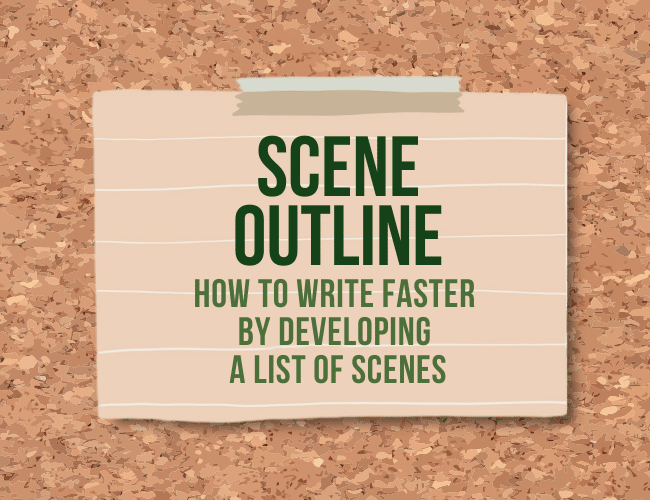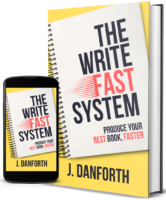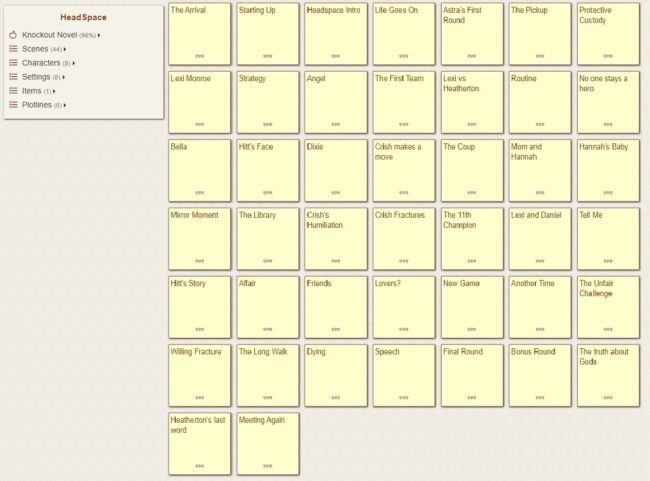Are you trying to write faster? Writing a scene outline might be exactly what you need. But what is a scene outline, and how you can create one that help direct your story while giving you creative freedom?

A scene outline can give your story plan focus and prevent burnout or confusion when actually writing your story.
In this article, you'll learn how to create a scene list that gives your big story idea focus, which will help you not only write faster, but give you a higher chance of actually finishing your book—and having fun while you write it!
This article is an excerpt from my book The Write Fast System, designed to help you write your book faster!
 Want to finish your best book faster? Get our new book, The Write Fast System, today (on sale for a limited time)!
Want to finish your best book faster? Get our new book, The Write Fast System, today (on sale for a limited time)!Get The Write Fast System – $2.99 »
Why This Simple List Quickened My Writing
It’s easy to come up with an overall idea for a book, but to break it down to the actual steps of getting from beginning to end is far more difficult. Suddenly, you’re faced with the prospect of dealing with character development, plot holes, story mechanics, logical sequence of events…the list goes on.
However, creating a scene list need not be difficult. I was once intimidated by this step as well, but once I figured out the basics of how a scene list should be created and used, I found it incredibly useful and helpful in writing my first draft. In fact, having a scene list is the biggest reason that I was able to finish a first draft in six weeks.
I’d like to share with you my personal method for creating and using scene lists and how it can help you finish your first draft quickly and efficiently.
Scene vs. Scene Outline
What is a scene?
A scene can be described as a series of continuous events that take place in a story. A scene is usually a self-contained event, with its own set of elements of plot. Scenes move the story forward one step at a time, and every time a scene ends, your reader should feel like they’ve become more immersed in the story world and more invested in the plot.
But thinking of a book in terms of scenes can feel daunting, especially if you're a pantser instead of a plotter.
However, whether you're screenwriting or writing a manuscript, building an outline of a story's scenes will help you keep track and understand if the main character's arc builds and the main events raise the stakes from beginning to end. Which means a scene list will likely help you avoid major rewrites after your finish writing your book.
Need help with what goes into a scene? Check out our guide to scenes here.
What is a scene outline?
A scene outline is a list of scenes that are needed in to story, including the main plotline and subplots. Drafting a manuscript without creating this list will likely slow down your writing process and could end with an incoherent plot.
You might want to consider the scene structure, or breakdown of events in each scene, when you create this list. However, it's most important to know the main elements in each scene, or the overall big idea of why the scene exists.
When to Make a Scene Outline
I see the scene list as the second step in planning. (The first being the five sections I think you need to plan before writing.)
As a quick refresher, I see these story sections divided into the following five parts:
- Beginning
- Beginning to Midpoint
- Midpoint
- Midpoint to End
- End
Using the article on this story structure, you may have created a five-part plan in your outlining process.
Once you've done this, you should consider how to list a detailed outline of your scenes—consistent with the number of scenes you want in your book.
The Number of Scenes in a Scene Outline
There is no hard and fast rule for this, and the number of scenes serves as a guideline only. Every book is different. Some may have as few as 10-15 scenes, and some may have hundreds. For commercial fiction, the average often falls somewhere between 30 and 45 total scenes.
I encourage you to have at least 40 scenes outlining your novel. This is a number flexible enough to add or subtract a few from and still be left with a book of decent length.
You can plot these scenes using index cards, or a writing program like Scrivener. You can organize them with scene headings (something relative to the main event that happens in a scene) or not.
Usually by the end of the book, the scenes I end up with are nothing like the ones I started with, but having this list provides a useful road map and prevents me from writing myself into a corner.
How to Make a Scene List
To create a scene list, get used to thinking of your book in a non-linear fashion. This means that rather than trying to figure out the sequence of events one after another, starting at the beginning, try to look at the book as a whole, tied together by a handful of key events.
Ask yourself:
- What are the main events that happen in my story's big picture?
- Do these have an external focus, or are they more concerned with the point of view's developing mindset?
Another thing to remember is that each scene in your list need not be detailed descriptions of everything that takes place in the scene. You can absolutely go into great details if you wish, but the point of the scene list is to create a flexible framework, not a rigid story outline.
For each scene in your scene list, you only need to address the following:
- Who is in this scene?
- Where does it take place?
- What is the main conflict of the scene? (Every scene has some sort of internal or external conflict; it can be as big as the completion of a major quest or as small as your character struggling to pick out a flavor of ice cream.)
- What does this scene accomplish? (Usually the answer to this is either the development of a certain character, or moves the story forward — i.e. brings it closer to the ending in some form.)
This is a good and simple scene template to use when organizing your scenes, and evaluating if they intentionally advance the plot.
Here are the basic steps I follow to start my scene lists:
- Write the beginning scene and ending scenes
- Write the middle scene (the Midpoint, which is referenced in this article)
- Write a handful (3-5) scenes between the beginning and middle scenes (these scenes are the key events that must take place on the path from the beginning to the middle)
- Write a handful (3-5) scenes in between the middle and the ending scenes (these are key events that must take place on the path from the middle to the end)
After these steps, I usually have around 10-12 scenes that address the major plot points of the book. At this point I look at what needs to go between each point, and I add other scenes as needed until everything is smoothly and logically connected.
I try to keep the number of scenes before and after the middle scene mostly the same. This is not a hard and fast rule, but more an exercise to ensure that the book starts off with a balanced structure.
Pro Tip: If you're a filmmaker and writing a script, it's more likely that the scenes will be exactly the same before and after the Midpoint.
Once I reach about 35 scenes, I read over the list and see if there are any major holes that need to be plugged.
Overall, I try not to exceed 45 scenes for one book. This is a personal preference. In my case, I write commercial fiction, and I've found that this is a good number of scenes to produce a commercial fiction novel, which usually has a word count of 80-90K words.
Having a tool that allows you to move and shift scenes around helps. There are a lot of people out there who like tools like Scrivener. Some keep it simple and just use Excel docs. I personally use Hiveword, a simple tool available online for a one-time payment.
How to Use a Scene List
You’ve made your scene list. You might be looking at it and thinking, “Wow, this is my book in scene form.”
Actually, it’s not.
There is something that people who don’t like to plan books often get wrong—you don't need to follow through your book plan to the letter. However, it is intended to be a living guideline, constantly changing. Don’t ever feel like you’re being restricted in your writing just because you have a plan.
The scene list is only a starting point.
Keep your scene list nearby as you start your book. Write the first scene, then the second, then the third. Chances are, sooner rather than later, you’ll find that you want to veer off this path. So what should you do when that happens?
Keep writing.
If you find yourself going off the path of the scene list, don’t sweat it. Want to change or add a character? Just do it. Want to switch up the order of events? No problem.
Once you’ve made that change, note it in your revisions list (to be addressed in a later article), check the next scene, and keep going.
There may be a ripple effect to your other scenes when you make changes. That doesn’t matter. Make the changes the best you can and if you can’t, let plot holes happen. There’s a reason it’s called a first DRAFT.
Whatever needs fixed will get fixed in future drafts. The first draft just needs to get written.
For an example, let’s take a look at my scene list for Headspace:

There are 44 scenes on this list, made using Hiveword. I arranged and rearranged, added and subtracted, until I arrived at this list. It probably looks nice and neat, all lined up. However, anyone who has read the book would laugh at this list.
Because it’s nothing like the final book.
I had major differences, like:
- The character Dixie never made it into the story. Not even the first draft.
- The protagonist’s mom was originally supposed to be alive. She ended up being dead long before the story began.
- The majority of the characters had different names by the second draft, and I frankly can’t remember what two-thirds of these scenes were supposed to be.
Still, having this list was immeasurably helpful. I was able to finish writing the book in six (count em'!) weeks because I never had to wonder about where to take the story next.
No matter how the details changed I knew Astra was headed toward her major mindset change in the middle of the book. I knew who she would bond with among the contestants of the game and what their relationships are like. I knew the secrets behind the man who catches her eye and what important events need to take place for their relationship to develop into something genuine.
In the end, despite the fact that I barely stuck to this list, it kept me focused and on track. I never once had to pause in my writing to figure out where to go next.
Which let me write faster, and with more focus.
Make Your Own Scene Outline!
Making a scene outline will organize your ideas, giving you confidence in your act structure, or how the big ideas build in your book.
While it may seem like making a list of scenes will diminish the fun of creative writing, it probably will actually do the opposite.
Writing a scene outline will help you have fun while writing, because you won't get confused about where your story is going or what your protagonist needs to do in order to get what they want (or not) by the end.
However, you don't need to overdo a scene outline if you don't want to. Keeping in mind the scene structure template shared in the article gives you the focus you really need to write faster with intention.
And if you want to take this a step further, try writing a synopsis before or after writing a scene list. Read it over. Did this make you feel excited about your story?
If it did, you're probably in a good place to write forward. And write faster, while you're at it.
Have you tried a scene list before? What feels most daunting? Let us know in the comments.
PRACTICE
Take fifteen minutes today and start making a scene outline for your story. Start with these scenes in the following five story sections:
- 1 scene for Beginning
- 1-3 scenes for Beginning to Midpoint
- 1 scene for Midpoint
- 1-3 scenes for Midpoint to End
- 1 scene for End
You need not spend more than 3-5 minutes on each scene. A simple paragraph is enough to present a summary of what should happen in the scene. Or, you can answer the questions suggested in there scene structure template in the article.
When you're finished, you will have a strong start to outlining you story's structure—and be on your way to writing your first draft faster.
If you want feedback, you can share in the Pro Practice Workshop. And if you share, please be sure to comment on a few stories by other writers.
J. D. Edwin is a daydreamer and writer of fiction both long and short, usually in soft sci-fi or urban fantasy. Sign up for her newsletter for free articles on the writer life and updates on her novel, find her on Facebook and Twitter (@JDEdwinAuthor), or read one of her many short stories on Short Fiction Break literary magazine.
this advice was the best i’ve found and has put me back on track writing my book. Thank you J. D.
This is an essential element of planning.